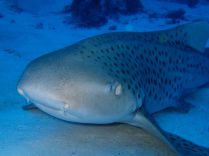Sharks
Sharks have fascinated me since childhood. I still remember my summer vacation in 1976 in the former Yugoslavia, when I was just 8 years old. Nobody wanted to go into the water because the Steven Spielberg blockbuster "JAWS" was playing in the cinemas. In 1990, I got my first diving license in Cairns, Australia, on the Great Barrier Reef, and during my training we saw whitetip reef sharks. After I also completed the "Advance Open Water Course" in Cairns (again in the company of whitetip reef sharks), I became so fascinated by diving that I booked a diving safari to northern Australia. We flew to Cooktown and then spent 8 days on a converted fishing boat that served as a dive boat to Port Douglas. The Ribbon Reefs with Cod Hole, with its giant spotted grouper, which can grow up to 180cm, was the first highlight, but what I found most fascinating was the constant company of various shark species. Blacktip reef sharks, whitetip reef sharks, and grey reef sharks were practically always there. Over the years, I've seen many different shark species in the flesh.
The most impressive were certainly the schools of hammerhead sharks near Apo Reef in the Philippines and the one large whale shark near the Similan Islands in Thailand.
There are approximately 500 species of sharks, but only a few are potentially dangerous. The most well-known are the great white shark, tiger shark, bull shark (also found in freshwater), oceanic whitetip shark, great hammerhead shark, and the blue shark.
The great white shark is arguably the most well-known shark (also due to the movies), but in reality they are true giants. The largest specimens measure over 6 meters (Haole Girl or Deep Blue are the two most famous female sharks) and weigh over 2 tons. The only natural predator of great white sharks is orcas.
Source Pic 1: E. Garcia / Sabang Beach / PG / PH
Source Pic 2: M. Geissler / PG / PH
All shark species have a more or less pronounced spindle-shaped body, which in some bottom-dwelling groups—such as carpet sharks, angel sharks, or saw sharks—may be strongly dorsoventrally flattened, similar to rays. The body can be divided into a head, a trunk, and a tail region, each characterized by specific organs and fins. The head region contains the primary sensory organs: the eyes, nostrils, ampullae of Lorenzini, and the mouth, which is used for feeding. Most shark species have a snout region that tapers to a greater or lesser point. In some species, such as nurse sharks and bullhead sharks, it is not developed. In hammerhead sharks, the head is very broad laterally, creating a very large distance between the eyes and nostrils located at the ends of the heads.
Between the eye and the gill slits lies the spiracle, which serves to absorb breathing water and is particularly large in bottom-dwelling species. The actual gill slits are located at the transition from the head to the body. The most primitive sharks, the grey sharks, which include the frilled shark and the combtooth shark, as well as the sixgill sawshark, have six or seven open gill slits on each side of their bodies. All other shark species have only five gill slits. The body area begins with the paired pectoral fins, which usually attach near or behind the last gill slit. On the ventral side, these are followed by the paired pelvic fins, which in males are connected to the paired claspers, the sharks' copulatory organs. On the dorsal side, there are usually two consecutive and unpaired dorsal fins, each of which often has a dorsal fin spine (especially in the spiny dogfish, named after them). In most shark species, the first dorsal fin is significantly larger than the second, which is usually located near the caudal peduncle and may be absent in some species. An unpaired anal fin is also often found on the ventral side of the caudal peduncle. Fast-swimming shark species also have lateral keels on their caudal peduncles.
The caudal fin consists of an upper and a lower fin lobe (lobe), with the lower lobe often significantly smaller than the upper one. This is particularly the case in bottom-dwelling species such as catsharks, but also in many open-water species, such as hammerhead sharks and, above all, thresher sharks. The latter have a significantly elongated upper caudal lobe, which they use for hunting. In fast-swimming species such as mako sharks or great white sharks, the tail is almost symmetrical.
Sharks have regenerating teeth; several rows of teeth grow behind the first row. A shark can grow up to 30,000 teeth in a lifetime. If a tooth in the first row breaks off, a new one replaces it, just as a new bullet in a revolver moves up the bullet drum (hence the name "revolver teeth"). Sharks often lose numerous teeth when attacking seals and fish.
A shark's eyes are ten times more sensitive to light than a human's, and most shark species are likely colorblind. Their eyes, located on the sides of their heads, allow them to see in almost all directions. When attacked, sharks protect their eyes either with a nictitating membrane that slides protectively over the eye like an eyelid, or by rolling their eyes backward.
A shark's olfactory organs are located on the sides of the snout. The olfactory center can make up to two-thirds of the brain mass. This allows sharks to detect blood diluted billions of times. The shark can detect its prey from great distances (over 75 meters), even when no other sensory stimulus provides information. By constantly moving its head ("pendulum motion"), it follows this scent trail to its target.
Hearing is less developed than in land animals. The ears are located on both sides of the braincase, and only a small pore is visible from the outside. Sharks react to low-frequency sounds below approximately 600 Hz (e.g., wriggling fish, singing whales, grunting seals, and fighting fish) and are highly sensitive to pulsating vibrations in the 100-hertz range, such as those produced by sick or wounded animals. Sharks can hear lower frequencies than humans. Sound waves as low as 10 to 800 Hz can be perceived. Hearing is also important for balance and orientation.
The lateral line organ of sharks runs from the head region to the tip of the tail and, like all fish species, serves to detect the smallest vibrations and pressure differences in the water. It contains sensory cells embedded in jelly. These can register water movements in the immediate vicinity, i.e., pressure differences (caused by prey, enemies, or obstacles) along the body surface. Sharks can also detect electrical fields generated by other creatures through heartbeats, muscle movements, or brain waves. The sharks’ electrical sensors are the ampullae of Lorenzini.
Source Pic: E. Garcia / Sabang Beach / PG / PH
Source Text translated from: https://de.wikipedia.org/wiki/Haie
| Shark Species | Shark Species (Scientific) | Maximum Size (Approximate) |
| Whale Shark | Rhincodon typus | 12 - 18 m (39 - 59 ft) |
| Basking Shark | Cetorhinus maximus | 10 - 12 m (33 - 39 ft) |
| Great White Shark | Carcharodon carcharias | 6 - 7 m (20 - 23 ft) |
| Great Hammerhead | Sphyrna mokarran | 5.5 - 6.1 m (18 - 20 ft) |
| Tiger Shark | Galeocerdo cuvier | 5 - 5.5 m (16 - 18 ft) |
| Greenland Shark | Somniosus microcephalus | 6 - 7 m (20 - 23 ft) |
| Bull Shark | Carcharhinus leucas | 3.5 - 4 m (11.5 - 13 ft) |
| Common Thresher Shark | Alopias vulpinus | 5 - 6 m (16 - 20 ft) (tail makes up almost half) |
| Shortfin Mako Shark | Isurus oxyrinchus | 3.5 - 4 m (11.5 - 13 ft) |
| Megamouth Shark | Megachasma pelagios | 5 - 5.5 m (16 - 18 ft) |
| Lemon Shark | Negaprion brevirostris | 3 - 3.5 m (10 - 11.5 ft) |
| Blue Shark | Prionace glauca | 3.5 - 4 m (11.5 - 13 ft) |
| Blacktip Reef Shark | Carcharhinus melanopterus | 1.6 - 2 m (5 - 6.5 ft) |
| Grey Reef Shark | Carcharhinus amblyrhynchos | 2 - 2.5 m (6.5 - 8 ft) |
| Sand Tiger Shark | Carcharias taurus | 3 - 3.2 m (10 - 10.5 ft) |
| Bluntnose Sixgill Shark | Hexanchus griseus | 4.8 - 5.5 m (16 - 18 ft) |
| Spotted Dogfish / Spiny Dogfish | Squalus acanthias | 1 - 1.5 m (3.3 - 5 ft) |
| Nurse Shark | Ginglymostoma cirratum | 3 - 4 m (10 - 13 ft) |
| Zebra Shark | Stegostoma fasciatum | 2.5 - 3.5 m (8 - 11.5 ft) |
| Angel Shark | Squatina squatina | 1.8 - 2.4 m (6 - 8 ft) |




